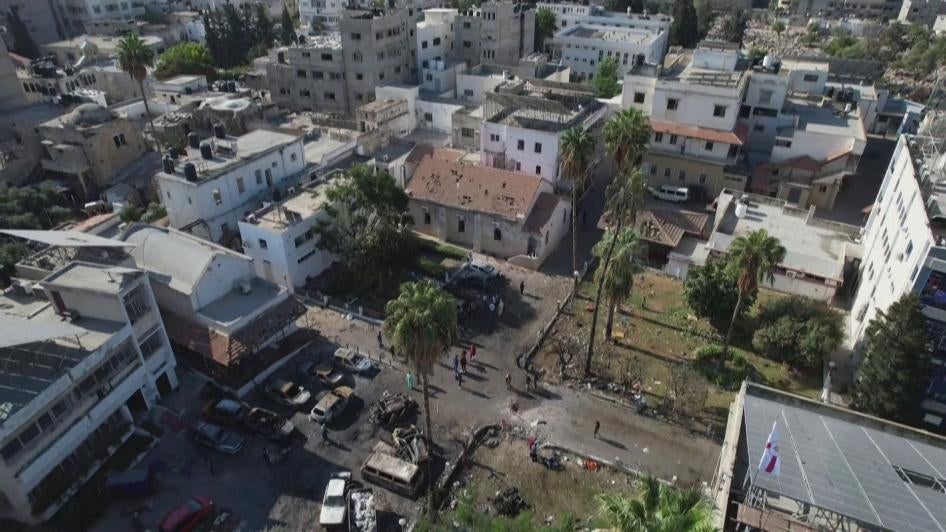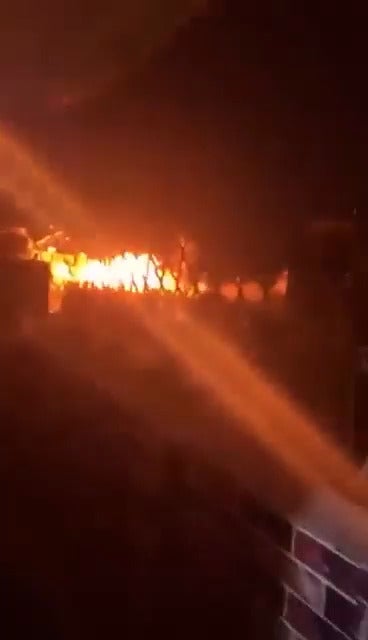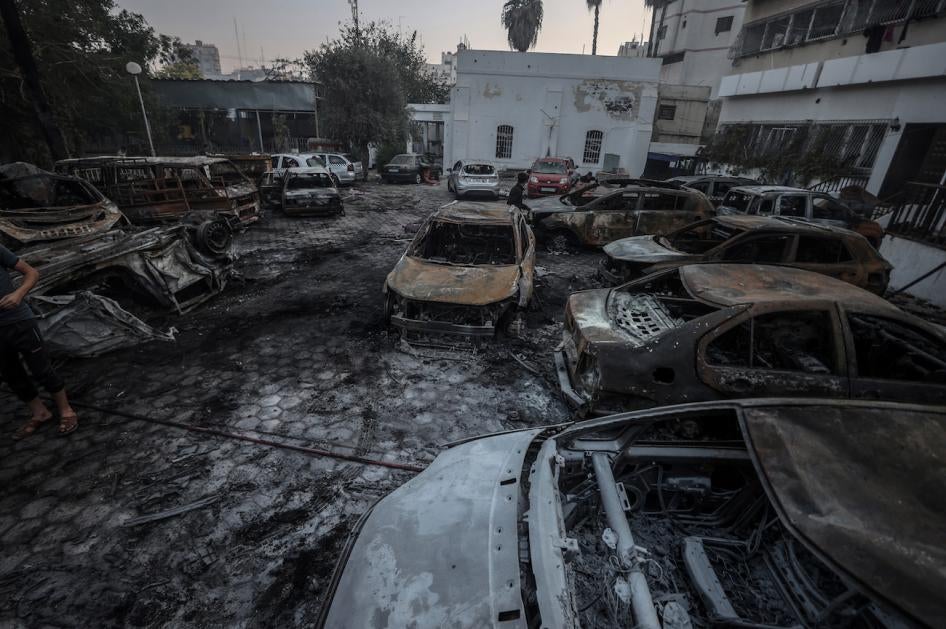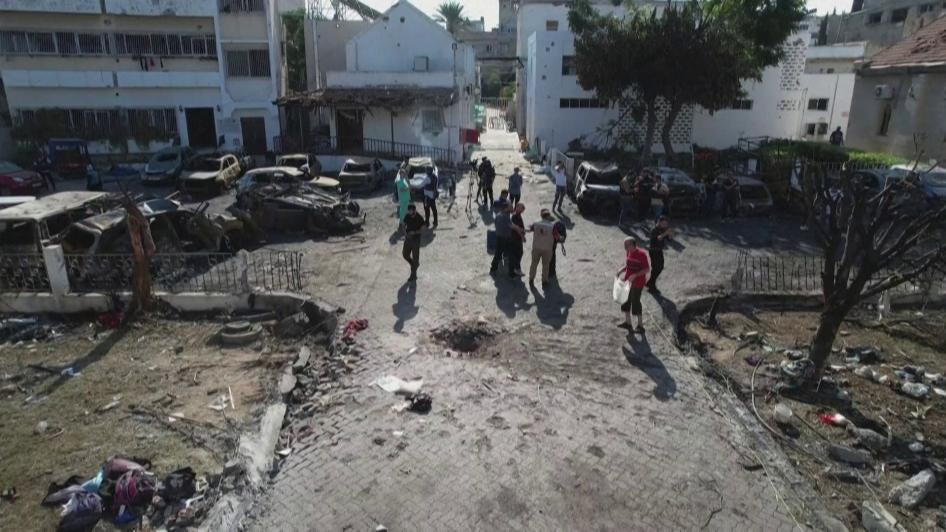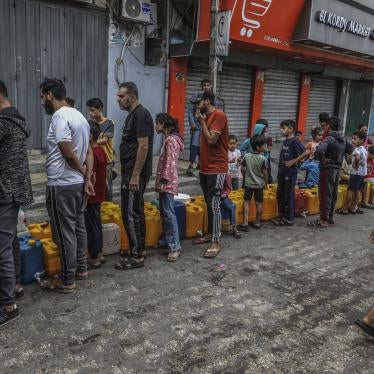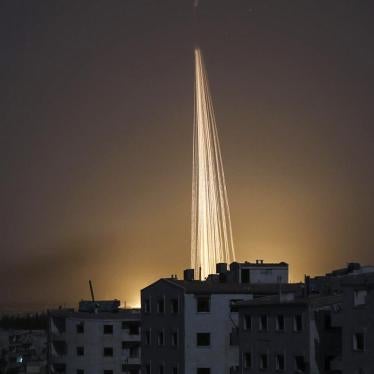(Jerusalem) – The explosion that killed and injured many civilians at al-Ahli Arab Hospital in Gaza on October 17, 2023, resulted from an apparent rocket-propelled munition, such as those commonly used by Palestinian armed groups, that hit the hospital grounds, Human Rights Watch said today. While misfires are frequent, further investigation is needed to determine who launched the apparent rocket and whether the laws of war were violated.
At 6:59 p.m. that day, a type of munition that Human Rights Watch has not been able to conclusively identify hit a paved area inside the hospital compound, between a parking lot and a landscaped area where many civilians congregated to seek safety from Israeli strikes. The Ministry of Health in Gaza reported that 471 people were killed and 342 injured. Human Rights Watch was unable to corroborate the count, which is significantly higher than other estimates, displays an unusually high killed-to-injured ratio, and appears out of proportion with the damage visible on site.
“The Human Rights Watch review of videos and photos suggests that on October 17 a rocket struck the al-Ahli hospital grounds,” said Ida Sawyer, crisis and conflict director at Human Rights Watch. “The victims and families of those killed or injured while seeking safety at the hospital deserve a full investigation to determine what happened and who was responsible.”
The Ministry of Health in Gaza said Israel was responsible for the explosion. The Israeli military said the explosion resulted from an Islamic Jihad rocket that misfired. The decades-long failure of both Israeli and Palestinian authorities to credibly and impartially investigate alleged violations of international humanitarian law underscores the need for an independent investigation into the incident, which could be conducted by the United Nations Commission of Inquiry, and for all parties to fully cooperate.
Human Rights Watch investigated the explosion by reviewing publicly available photos and videos, analyzing satellite imagery, interviewing five witnesses to the incident and its aftermath, reviewing analyses published by other organizations, and consulting experts. The remote analysis assessed the explosion and the damage on site, as well as several possible trajectories of the objects visible on videos taken at the time of the attack, which also showed the moments before and after the explosion at the hospital.
“There was nowhere to walk, because there were body parts everywhere and people injured and dying,” a journalist who arrived at the hospital an hour after the blast told Human Rights Watch. “The people at the scene were mainly children, older people, women.”
There are no known images of any munition remnants publicly available, and Human Rights Watch was unable to visit the scene, preventing conclusive identification of the munition.
However, the sound preceding the explosion, the fireball that accompanied it, the size of the resulting crater, the type of splatter adjoining it, and the type and pattern of fragmentation visible around the crater are all consistent with the impact of a rocket.
Evidence available to Human Rights Watch makes the possibility of a large air-dropped bomb, such as those Israel has used extensively in Gaza, highly unlikely. The Israeli military has dropped thousands of such bombs across the Gaza Strip since October 7.
Gaza authorities appear to be in possession of remnants that would help make a conclusive determination of the munition that exploded at al-Ahli hospital. A photo taken the evening of the explosion shows employees of the Explosive Ordnance Department, a specialized Gaza police unit, working on the crater. A witness who was at the hospital on the evening of the explosion told Human Rights Watch that employees of “the Ministry of Interior took all the shrapnel that was on the site.”
A Hamas official said the remnants would “soon be shown to the world.” More than a month after the events, this has not happened. Ghazi Hamad, a senior Hamas leader and deputy minister in the Hamas-led Gaza governing authority, told the media on October 22 that “the missile has dissolved like salt in the water.… It’s vaporized. Nothing is left.” Human Rights Watch noted that substantial portions of munitions typically survive a detonation, even if parts of munitions are designed to break apart and may be made unrecognizable by thermal damage.
On November 25, Bassam Naim, head of the political and foreign relations department of Hamas, responded to several of the questions about the October 17 explosion that Human Rights Watch had sent to the Ministry of Interior in Gaza. He said that the ministry’s investigation of the strike had been slowed by the ongoing hostilities but that “the preliminary information we have definitively points to Israel’s responsibility.” He said that Israeli authorities warned the hospital to evacuate “hours” before the explosion and claimed that “no Palestinian resistance faction – to our knowledge – has among its weapons a projectile or a rocket of the destructive power capable of killing a large number of people as the bomb used in this incident of targeting” the hospital.
Human Rights Watch found that a rocket such as the larger types fired by Palestinian armed groups could inflict a high number of casualties if it struck with some of its propellent remaining in a courtyard packed with people and flammable materials. All hospitals in northern Gaza, including al-Ahli, had received general orders to evacuate on October 13 and the days that followed.
Naim did not respond to several specific questions, including about the munition remnants and military operations by Palestinian armed groups on the evening of the explosion. However, he said that Hamas, in coordination with the relevant authorities, would provide all evidence “as soon as possible” and that Hamas welcomes independent investigations into the incident.
Gaza authorities and Israel should publicly provide all information that they hold regarding the incident, in particular evidence concerning the munition remnants. Medical records showing the types of injuries sustained by the victims, subject to privacy and confidentiality protections, and other types of evidence such as unpublished videos of the explosion, could also shed light on the cause of the explosion.
Israeli forces have carried out repeated, apparently unlawful attacks on medical facilities, personnel and transport during the current hostilities, which Human Rights Watch has documented. The World Health Organization (WHO), as of November 24, had documented 187 attacks on health care in Gaza since October 7, which damaged 24 hospitals, according to data shared with Human Rights Watch. The WHO has said that, as a result of the hostilities, the majority of hospitals in Gaza were no longer functioning.
Since October 7, Palestinian armed groups have unlawfully launched thousands of rockets at Israeli communities, causing death, injuries, and property damage.
The Independent International Commission of Inquiry on the Occupied Palestinian Territory, including East Jerusalem, and Israel, established by the UN Human Rights Council in 2021, has a mandate to “to investigate, in the Occupied Palestinian Territory, including East Jerusalem, and in Israel, all alleged violations of international humanitarian law and abuses of international human rights law leading up to and since 13 April 2021.” On October 10, the Commission of Inquiry announced that it is “collecting and preserving evidence of war crimes committed by all sides since 7 October 2023.”
International humanitarian law, or the laws of war, grants special protection to hospitals and other medical facilities, the injured and sick, as well as medical staff and transport: they must be protected and respected in all circumstances.
States should suspend military assistance and arms sales to Palestinian armed groups, including Hamas, so long as they continue to systematically commit attacks amounting to war crimes against Israeli civilians. Governments should suspend military assistance and arms sales to Israel so long as its forces commit widespread, serious abuses amounting to war crimes against Palestinian civilians with impunity.
“The explosion at al-Ahli hospital is one of scores of strikes damaging medical facilities across Gaza that have killed civilians and medical professionals and denied many Palestinians access to desperately needed medical care,” Sawyer said. “Authorities in Gaza and Israel should release the evidence of munition remnants and other information they have regarding the al-Ahli hospital explosion to allow for a full investigation.”
Events Surrounding the Explosion
Analysis of videos shows that a barrage of Palestinian rockets was launched from a location approximatively five kilometers southwest of the al-Ahli hospital toward the northeast 43 seconds before the explosion at the hospital. Human Rights Watch is unable to confirm whether the barrage of rockets fired by an unidentified Palestinian armed group and visible on videos flew, or not, over the hospital: the rockets are only visible for the first seconds after their launch as bright dots, and their subsequent flight path through the night sky cannot be established with precision.
Meanwhile, the areas around the hospital – in particular, the mostly residential neighborhoods of Sheja’iya and Zeitoun – were under intense attack by the Israeli military when the hospital explosion occurred, said two witnesses. Explosions are visible near the hospital on a livestream from the Al Jazeera media network in the minutes preceding and following the hospital explosion. The video shows two explosions in proximity of the hospital before the hospital explosion (both at 6:55 p.m.) and four in the following minutes (at 7:03 p.m., at 7:04 p.m., and two at 7:05 p.m.). Due to nighttime darkness and lack of an alternate point of view, it is not possible to assess exactly where these explosions occurred. Smoke is already visible northeast of the hospital at the beginning of the livestream, at 6:53 p.m., indicating that additional explosions could have happened in the minutes before the hospital explosion.
Videos show a munition rising and exploding in the air seconds after the Palestinian rocket barrage and before the hospital explosion. Our analysis found that this projectile was likely to be an Israeli interceptor missile, which appears to strike a rocket mid-air above Israeli territory at a distance too far for the falling debris to have caused the explosion at the hospital.
Videos analyzed by Human Rights Watch show, seconds before the explosion, what seem to be Israeli aircraft above the sea west of the hospital apparently releasing multiple luminous objects consistent with the deployment of pyrotechnic countermeasures, also called flares or decoys. These countermeasures are designed to protect the aircraft from heat-seeking munitions by confusing the weapon’s seeker head. Three sets of countermeasures are visible: two roughly 32 seconds before the explosion, and another in the few seconds preceding and following the explosion. While this confirms that Israeli jets were nearby at the time of the strike, Human Rights Watch found no evidence that points to them being responsible for launching the munition that hit the hospital grounds.
The Hospital Explosion
In one video, verified and geolocated by Human Rights Watch and filmed 160 meters from the hospital in the instant before and during the main explosion, the sound characteristic of a munition propelled by a motor, such as a rocket or a missile, can be heard. This sound is not consistent with artillery shells or air-dropped bombs. The video shows a large fireball that accompanied the explosion, which is consistent with the ignition of rocket propellent and perhaps other fuel burning.
Damage Analysis
Photos and videos taken at the site, shared on social media and by news media, show a crater. Human Rights Watch used photogrammetry techniques to measure the crater, determining that it is approximately 90 centimeters long, 60 centimeters wide, and has a maximum depth of approximately 30 to 40 centimeters. This crater size is inconsistent with the point detonation of a large, air-dropped bomb with a high-explosive payload.
The crater lacks features – such as lateral spray and a fuze furrow – that are characteristic of spin-stabilized artillery projectiles fired at a low angle (below 45°). The limited blast damage around the crater is inconsistent with high-explosive detonations such as those that accompany the impact of large air-dropped bombs or the anticipated effects of munitions fired by weapons systems that the Israeli military has acknowledged using in Gaza in this round of conflict.
The extensive fire damage to cars in the hospital parking lot is inconsistent with the detonation of a high-explosive warhead alone. The fires appear to have been caused by burning rocket propellent that would have spread to – and ignited – fuel or some other flammable material present on the site. A video of the parking lot, filmed the day after the explosion, shows a gas cylinder, such as those used for cooking, in one of the vehicles. A nurse at the al-Shifa hospital, where the wounded from the explosion were taken, said that most suffered second- or third-degree burns.
The fragmentation pattern around the crater – the damage that flying parts and debris caused to surrounding surfaces during the explosion – appears to be natural fragmentation from the body of the munition. The fragmentation pattern lacks uniform patterns caused by common air-defense missiles or other munitions that have warheads that contain pre-formed fragmentation, such as variants of Hellfire or Spike guided missiles frequently used by the Israeli military.
Casualties
Five witnesses to the aftermath of the explosion described horrific injuries, including dismemberment, caused by fragmentation. While the Ministry of Health in Gaza said 471 people were killed, Mohammed Abu Selmia, the general director of al-Shifa Hospital, which received the victims, told the media the death toll was closer to 250. Human Rights Watch reviewed two images published by the Associated Press stating to show victims of the al-Ahli explosion who were brought to al-Shifa Hospital in Gaza City, including an image taken during a news conference that a representative from the Ministry of Health in Gaza and medical staff from the hospital gave regarding the explosion. These images display between 65 and 75 body bags, rolled-up carpets, and bodies. Human Rights Watch could not independently verify whether all of these victims were from the al-Ahli explosion.
October 14 – Three Days Before the Explosion
On October 14, three days before the major explosion, a remnant of an artillery projectile struck the hospital’s diagnostic cancer treatment center, damaging two floors and reportedly injuring four medical workers, according to the Chaplain to the Archbishop of the Episcopal Church of Jerusalem and the Middle East, which runs the hospital. The chaplain published a video on social media showing the damage to the diagnostic center, which appears kinetic and nonexplosive, and a remnant of an illumination flare on the floor of one of the rooms, covered in debris. The remnant pictured is part of the munition that falls to the ground once the flare is ejected over a target area. Israel is the only party to the conflict known to possess and use the artillery that fires this type of munition.
The Archbishop of the Episcopal Church of Jerusalem and the Middle East said in a news conference that on October 14, 15 and 16, al-Ahli hospital received at least three phone warnings to evacuate, though he did not provide details about the source or content of the warnings. Yousef Abu Reesh, spokesperson for the Ministry of Health in Gaza, said on the evening of October 17 that the warnings had been given by the Israeli military to the director of the hospital. The Israeli military has said that it gives phone warnings to civilians to evacuate.
Rocket Misfires
The rockets that are extensively used by Palestinian armed groups such as Hamas and Islamic Jihad have only rudimentary guidance systems and are prone to misfire, making them extremely inaccurate and thus inherently indiscriminate when directed toward areas with civilians. All such rockets launched toward populated areas violate the laws-of-war prohibition against intentional or indiscriminate attacks against civilians. Those who order or carry out such attacks with criminal intent – deliberately or recklessly – are responsible for war crimes.
Human Rights Watch has previously reported on rockets that have misfired and struck areas in Gaza. Research citing data released by the Israeli military has suggested that between 10 to 20 percent of rockets launched from Gaza have failed. Data on the overall numbers of projectiles (for example, rockets and mortars) fired as well as their success or failure rates are estimates and should not be considered precise.
Human Rights Watch has documented the death of civilians in Israel in rocket attacks by Palestinian armed groups, as well as the death of seven civilians in Jabalya, Gaza, on May 10, 2021, as a result of a rocket misfire. Human Rights Watch made the determination that the 2021 incident was a rocket misfire and not an Israeli strike based on site visits and analysis of video of the incident and available munition remnants.
Documenting damage caused by misfired rockets is difficult because the authorities in Gaza have impeded investigations of such incidents. For example, authorities in Gaza detained two Palestinian journalists investigating rocket misfires during the August 2022 escalation.
Hostilities and Blockade
The Israeli military’s current operations in Gaza began following a Hamas-led attack on Israel in which an estimated 1,200 people, including children and hundreds of other civilians, were killed and more than 200 people were taken hostage, according to Israeli authorities. As of November 23, 14,800 Palestinians had been killed in Gaza, including about 6,000 children, according to local authorities in Gaza. Israel has cut off essential services to Gaza and is preventing the entry of all but a trickle of aid. On November 22, Israeli authorities and Hamas agreed to a multiple-day ceasefire, an increase in the entry of fuel and aid, and the release of dozens of civilians held hostage in Gaza, in exchange for the release of scores of Palestinian prisoners.
